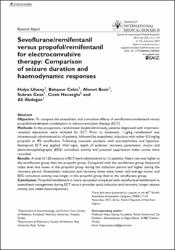| dc.contributor.author | Ulusoy, Hülya | |
| dc.contributor.author | Çekiç, Bahanur | |
| dc.contributor.author | Beşir, Ahmet | |
| dc.contributor.author | Geze, Sükran | |
| dc.contributor.author | Hocaoğlu, Çiçek | |
| dc.contributor.author | Akdoğan, Ali | |
| dc.date.accessioned | 2020-12-19T20:13:21Z | |
| dc.date.available | 2020-12-19T20:13:21Z | |
| dc.date.issued | 2014 | |
| dc.identifier.citation | Ulusoy, H., Cekic, B., Besir, A., Geze, S., Hocaoglu, C., Akdogan, A., (2014). Sevoflurane/remifentanil versus propofol/remifentanil for electroconvulsive therapy: Comparison of seizure duration and haemodynamic responses. Journal of International Medical Research, 42(1), 111-119. https://doi.org/10.1177/0300060513509036 | |
| dc.identifier.issn | 0300-0605 | |
| dc.identifier.uri | https://doi.org/10.1177/0300060513509036 | |
| dc.identifier.uri | https://hdl.handle.net/11436/4011 | |
| dc.description | PubMed: 24398757 | en_US |
| dc.description.abstract | Objective: To compare the anaesthetic and convulsive effects of sevoflurane/remifentanil versus propofol/remifentanil combination in electroconvulsive therapy (ECT). Methods: In this prospective, randomized double-blind study, patients diagnosed with treatment-resistant depression were included for ECT. Prior to treatment, 1 ?g/kg remifentanil was intravenously administered to all patients, followed by anaesthetic induction with either 0.5 mg/kg propofol or 8% sevoflurane. Following muscular paralysis with succinylcholine and hypnosis, bitemporal ECT was applied. Vital signs, depth of sedation, recovery parameters, motor and electroencephalography (EEG) convulsion activity and postictal suppression index scores were recorded. Results: A total of 120 sessions of ECT were administered to 12 patients. Heart rate was higher in the sevoflurane group than the propofol group. Compared with the sevoflurane group, bispectral index level was lower in the propofol group during the induction period and higher during the recovery period. Anaesthetic induction and recovery times were lower, and average motor and EEG convulsion activity was longer, in the propofol group than in the sevoflurane group. Conclusion: Propofol/remifentanil is more successful compared with sevoflurane/remifentanil in anaesthesia management during ECT since it provides quick induction and recovery, longer seizure activity and stable haemodynamics. © The Author(s) 2014. | en_US |
| dc.language.iso | eng | en_US |
| dc.publisher | Sage Publications Ltd. | en_US |
| dc.rights | info:eu-repo/semantics/openAccess | en_US |
| dc.subject | Anaesthesia | en_US |
| dc.subject | Electroconvulsive therapy | en_US |
| dc.subject | Propofol | en_US |
| dc.subject | Seizure | en_US |
| dc.subject | Sevoflurane | en_US |
| dc.title | Sevoflurane/remifentanil versus propofol/remifentanil for electroconvulsive therapy: comparison of seizure duration and haemodynamic responses | en_US |
| dc.type | article | en_US |
| dc.contributor.department | RTEÜ, Tıp Fakültesi, Dahili Tıp Bilimleri Bölümü | en_US |
| dc.contributor.institutionauthor | Hocaoğlu, Çiçek | |
| dc.identifier.doi | 10.1177/0300060513509036 | |
| dc.identifier.volume | 42 | en_US |
| dc.identifier.issue | 1 | en_US |
| dc.identifier.startpage | 111 | en_US |
| dc.identifier.endpage | 119 | en_US |
| dc.relation.journal | Journal of International Medical Research | en_US |
| dc.relation.publicationcategory | Makale - Uluslararası Hakemli Dergi - Kurum Öğretim Elemanı | en_US |


















